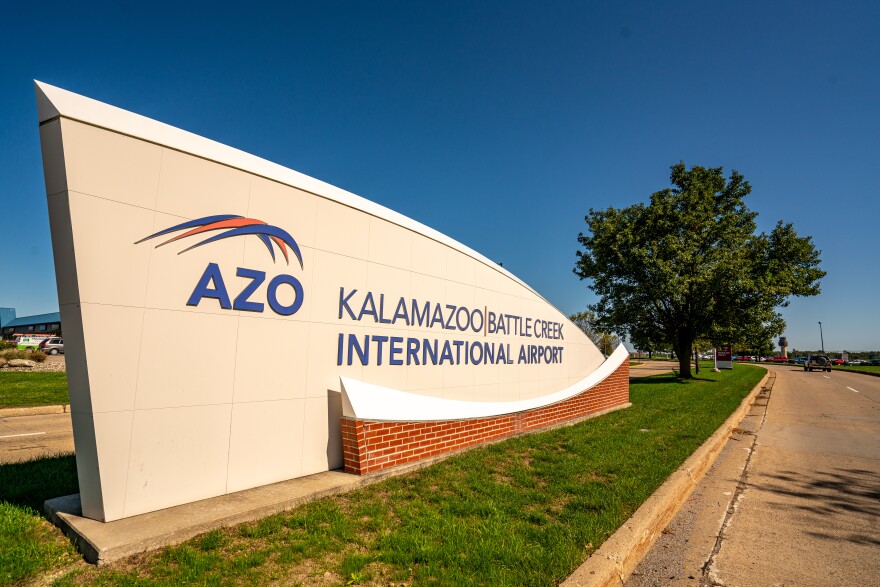Matthew Schuld of Kalamazoo flies out of the Kalamazoo-Battle Creek International Airport a couple times a year. He recalls a discussion he saw in the Vanished Kalamazoo Facebook group.
“Somebody had showed some images of flights that were coming in probably in the 70s and was discussing about how easy it was to get back and forth between Chicago and how often you could catch a flight back then,” Schuld said.
“And I was just curious about how that changed over the last few decades. And what led to it.”
The airline industry has changed dramatically since the 70s, and that’s affected how many flights are available. More recently, the pandemic caused a steep decline. Now there’s debate about why the number of flights hasn’t rebounded in places like Kalamazoo. We’ll explore that more detail. But first we look at longer-term trends in the industry.
In the late 1970s Congress lifted a number of restrictions on airlines. Suddenly, they could set their own routes and airfares. Competition went up as fares began to fall. But many companies over-expanded and failed within a decade.
This instability led many airlines to merge. And the wave of mergers was still going on in the aughts. Craig Williams is the airport director.
“For example, you had Northwest Airlines, which was big in Michigan, and certainly had a large presence,” he said.
But Williams says Northwest went away when Delta bought the airline. That happened in 2008.
“US Airways went away when they merged with American. Continental Airlines went away when they moved with United,” he added. “Kalamazoo at one time had six or seven airlines. But again, it's not that they left Kalamazoo. They just left existence.”
A state database shows numbers of passengers at Michigan airports, going back to 1950. It suggests the 1990s were an even better time to fly AZO than the 1970s: the airport had 503,388 scheduled passengers in 1997, compared with just 213,268 in 1977. In 2007 the number had declined a little, to 378,989; by 2017, almost 10 years after Northwest was bought by Delta, the number was down to 295,038.
This led to fewer flights at regional airports like the one in Kalamazoo. But if consolidation caused a trickle of decline, Covid-19 caused a flood. Air travel plummeted across the country. Including at A-Z-O, with the total number of passengers dropping by more than 95% from March to April of 2020.
Williams said airlines looked for ways to save money. Including shrinking the number of pilots on staff.
“When this first happened, the airlines gave a lot of pilots an opportunity to retire, or they aged out. So a lot of those pilots said, ‘Sure, we'll go ahead and take that retirement opportunity and did that,’” he said.
But Williams said the industry bounced back more quickly than the airlines expected, especially in leisure travel. This is where theories about why flights haven’t rebounded begin to conflict.

The airlines say they’re still short on flights because there aren’t enough pilots. It’s the reason United gave for leaving Kalamazoo in January. But the Air Line Pilots Association or ALPA says that’s a smokescreen.
Instead, the union claims airlines are using a false shortage to pressure regulators to lessen training and safety standards.
In any case, the Kalamazoo airport has seen flights drop more than 50 percent since the fall of 2019. And now it may see some knock-on effects from that drop.
Selim Ozyurek is an assistant professor in Western Michigan University’s College of Aviation. Ozyurek says with fewer flights from Kalamazoo, passengers from AZO may have to wait longer for their connecting flight. Which may make flying local less attractive.

“If there's high waiting time, in Chicago, or Detroit, then people instead of taking the flight from Chicago, from Kalamazoo to Chicago or from Kalamazoo to Detroit, they may select to drive over there in order to decrease the waiting time,” Ozyurek said.
However, the airport also had some good news this year. Budget airline Avelo announced non-stop flights to Orlando in July. (It later announced it would also fly to Fort Myers, but suspended that service after damage from Hurricane Ian.)
Airport director Craig Williams says low-cost airlines may offer a path to growth. He adds, airlines are leaning into vacation travel, as virtual work makes business travel less essential.
“Because the leisure travel, our desire to go to nice destinations with our families did not go away. You can't zoom your way to the beaches,” he said.
Our question-asker Matthew Schuld laments missing out on the glory days of airline travel.
“But I think, in general, I think, travel-wise, we'll just have to expect to use Kalamazoo when we can but also, you know, be adaptable to traveling to Grand Rapids, or Lansing or Chicago or Detroit, just depending on what makes the most sense,” he said.



